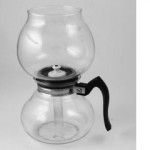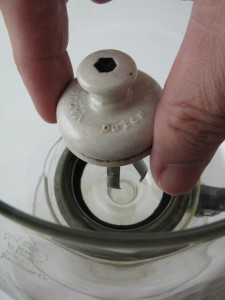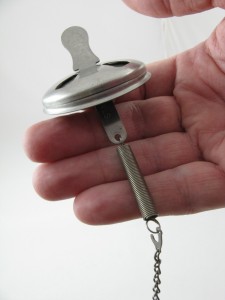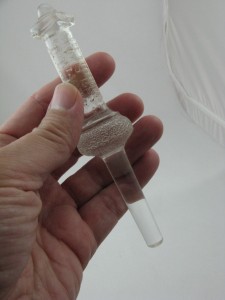Back before automatic drip dominated the coffee scene, the most common brewer in kitchens, diners and doughnut wagons was the vacuum percolator. While the vacuum seems like a complicated method, it is actually quite simple, although it’s hard for me to imagine how anyone thought it up.
How does it work? — The vacuum is a bad name, because the vacuum part doesn’t come unit the end. The idea is this: water is boiled in a lower half. As it reaches boiling, a stemmed upper half is inserted. The steam in the lower half expands and pushes the water up through the tube, through a filter and into the upper bowl. This upper bowl contains ground coffee. After a minute of contact where the hot water and ground coffee mix together, the lower half is removed from heat. As the lower bowl cools, this causes a vacuum to form and it drags the upper bowl’s freshly brewed coffee through the filter, down the tube and into the lower bowl. When that’s finished, the upper bowl is removed and you now have a nicely extracted pot of coffee.
There are electrified automatic versions, but they work in principal the same way. A second method places the two bowls together from the start, but I prefer putting them together only once the water reaches boiling because I want the water kept away from the grounds until we begin timing the contact time.
Temperature — The vacuum virtually automatically brews at between 195 and 205 Fahrenheit. Even though the water is boiling when you place them together, once the water rises through the tube and begins mixing with the ground coffee, it is usually at 205 or lower. Many people assume its boiling because the water bubbles as it mixes with the ground coffee. This is simply air escaping from the lower bowl, not boiling. Historically, there is evidence that the Coffee Development Group created its standards by observing a vacuum maker, which was very popular at the time.
Time — The time is user controlled, or at least user affected. A certain amount of predictive engineering is expected. You remove the brewer from heat after one minute in hopes the brewed coffee will take three minutes to descend back into the lower bowl, bringing the contact time to a four minute total. This is perfect for a fine grind, and if you use an old supermarket grinder, there will be a setting marked vacuum or “glass” and this is the setting for a four minute extraction.
This is wonderful…when it works. I’ve used vacuum brewers for fifteen years and I can say that 90% of the time, that’s just what happens. But, if there’s any micro gap in the seal between the bowls, if the filter gets clogged with too-fine coffee or for any other atmospheric reason, there is always a possibility of a standstill as the coffee stops descending. Once it’s stuck there are a number of possible fixes. Sometimes I just have to start over. This isn’t very often, but often enough to acknowledge it here.
Extraction — There is no more thorough extraction method known to me than the vacuum. All the grounds are completely submerged in a very short time period and the bubbling water seems to add what is sometimes called turbidity. It’s the idea that fapidly moving water facilitates extraction. Whether this is provable scientifically or not, it sure seems to work, enough so that the vacuum is always my brewer of choice whenever I get a light-tasting coffee. If the vacuum won’t bring out it’s notes, my view is that no method will.
Spent grounds show just how effective vacuums are at
extracting every last drop of coffee flavor.
Taste — The vacuum does best with high-acidity coffees. It’s high temperature, that stays high throughout extraction, is just the ticket for light roasted coffees. I found it nigh perfect for Allegro’s Mexican Chiapas and its spicy notes. Armeno Coffee roasters has a number of light roast coffees that performed splendidly with the vacuum, where I was detecting a slight sourness when these same coffees were brewed using a Chemex. The coffee is, if anything, too hot when brewing is completed. If you really like hot coffee, this is your method. I simply use it as a great opportunity to clean the upper bowl while waiting for my cup to come to a reasonable drinking temperature.
Filter notes: No method offers a greater range of filter choices than the vacuum. This particular vacuum, purchased off eBay, features Vaculator’s proprietary ceramic filter held in place by stainless steel clips. The idea, as with glass rods, is to offer a slightly bumpy surface that, when placed in contact with a glass or metal bowl, allows the liquid to pass through, but little or no particulate. You end up with something in between the thick almost-unfiltered French press brew and the cleanness of automatic drip using paper filters. Some would say it’s the perfect compromise. Meanwhile, there are still cloth and paper filtered vacuums as well as a metal spring type that used to be the standard in restaurants. All allow some sediment except for paper.
Cleanup — The vacuum is slightly easier to clean than a French press. While there’s no press to disassemble, there are grounds to either wash down a sink or transfer to waste or, best of all, a compost bin. The worst attribute of the vacuum is the fact that the upper bowl must be removed while it’s still piping hot. If it’s glass, there’s an increased risk that it will break. I’ve broken more than one. Metal ones won’t break, but the hot part is still awkward. There are some ingenious answers to where to put the still-hot, still-grounds-filled upper bowl. A metal one can be laid on its side. The grounds are usually so drained of coffee that they are like a solid mass that will stay put until you clean it.
Conclusion — If you’re looking for the ultimate extraction experience, this brewer may fill the bill. It is not hard to use or clean. The biggest time challenge is waiting for the water to heat up on a stove, or hot plate. Sometimes, I split the water and transfer some to a separate tea kettle to boil, but that’s more trouble than you probably want to go to. If you’re in a hurry, there are other methods that will be more appealing. Even if it happens once, you won’t soon forget a stalled vacuum as described above. Waitresses used to wrap cold towels to attempt to induce the vacuum to cooperate and release the coffee to its lower bowl.
In short, it’s a wonderful method, but I would want another machine as a primary or backup one.







Requesting information on how to purchase the stainless steel spring filter for my Vintage Nicro Vacuum Coffee Pot. Please respond as soon as your able. Thank you, John Barron
Thank you. A good question. I’m unaware of any current manufacturers. Two ideas: eBay and antique stores, where I’ve picked up several vacuum filters. Although the metal filters are less common, I’ve found glass rods (which may also work for you) at antique shops, often misidentified. How long a filter do you need? I will be happy to check for spares in my meager collection and other readers may also respond.
I have a nicro filter for sale, they are increasingly rare
I have searched high and low and trying to locate just the “stainless steel spring filter” for my Corey Vacuum Brewer…Do you have any suggestions at all?
Hi Georgia, I would search eBay. They are often in antique stores too, frequently mis-marked because shop owners don’t know what they are. You might consider trying one of the other brands, although the lengths of the springs may be different. I empathize. Use the term “vacuum coffee filter” in searching eBay. Good luck.
Water vapor does not take up more room than air. The air above the water, when heated, will eehtir gain volume or gain pressure. The air gains a slight amount of pressure and pushes the water the only place it can go, up the tube. This allows that air to stay at a lower pressure, but a higher volume. Also, for an eight cup siphon I believe one minute is too short a brewing time. I use: 2-3 cup 70 seconds, 5 cup a little less than 2 mins, and 8 cup about 3 full minutes
Interesting. I’m concerned that you are getting such different contact times for various volumes. Why is this? I think they should be constant based upon the grind fineness. Keep in mind if you keep the hot water up there for one minute, and it takes three minutes for the brew to return, that is four minutes of contact time between the hot water and the grounds. This is plenty of time for the extraction to occur. Traditionally, vacuum coffeemakers use a finer grind than drip. But at this year’s CoffeeCON I sampled several different ways a vacuum can be used. Enjoy it how you wish.
Since you seem to want to debate the topic, I will reeapt that I love both methods. The syphon pot method is another great way to make coffee. There is not a competition. Preground coffee sold in stores is already stale, you would be better served to switch to whole bean and grind at home. The autodrip’s sole attribute is convenience, because the flavor is really subpar. French press and syphon pot totally crush the autodrip method and there is no comparison!
Thank you for your comments, but who’s debating? My review states my appreciation of this method. Siphon method requires constant attention, my only caveat. However, I do take issue that drip is subpar. Drip, done correctly, can be wonderful. I wonder why it has to be a competition. I don’t think it is one.
Now now mr Shafer The french press does make a great cup and many peferr it to the syphon, but not me! There are about 2 oz of water that remains in the bottom chamber, but this is a small amount compared to the 40 that are syphoned into the upper bowl. The syphon pot does not create a watery cup, that I can assure you! My favorite method is espresso, but the vac pot is my favorite non-espresso way. To each his own, and that is a great thing about coffee!
I have successfully resorted the equivalent size made by Hario
it has a cloth cover, but works perfectly
I am trying to find parts for two Nicro coffee makers that date back to 1969. I need the chain part that goes in to perk the coffee thru. I think it is called a spring filter. If anyone could help I would be very happy. It,s for my aunt who lives in France Thank You so much Jackie
Diguo Permanent Coffee Filter for All Hario Siphon Coffee Maker and Other Syphon Coffee Maker (White)
by Diguo
Color: White or Brown
Stainless steel filter mesh for all siphon maker
stainless steel reusable mesh filter which allows for more oils and a fuller bodied cup of coffee than the clothe filter
Easy to assemble and saperate from the unit. Easy to cleaning Long term uses OK
No cloth smell again with this Siphon filter
Main Material: Stainless Steel 18/8. Food grade silicon case
1 new from $18.90
Yama Stovetop Vacuum Coffee Brewer Spare Part 8 Cup Filter Screen
$6.77
More Buying Choices
$6.77new(2 offers)
4.3 out of 5 stars
Hello,
I own a Yama model. It works well. Keep in mind it is not as robust as some more costly models, such as those made by Hario. But, knowing how delicate it is, I’ve been able to use it effectively for several years. There are all kinds of filters around. I attended the Hario siphon seminar at CoffeeCon LA, and learned how to use and store a cloth filter. Cloth certainly is considered standard for filtration and long-time devotees claim its superiority to all others. I find the glass rod works very well, albeit it does tend to necessitate extra care when stirring.
please contact me at my email or phone 719-930-5404
Hi Jacqueline,
I have posted your request. I hope someone has one, but just in case, consider these two options: 1) Hario currently makes a cloth filter with a spring that can be made to work with most vacuum makers. 2) Go to eBay and search “vacuum filter”. Among the choices will be several Cory Rods, which are glass rods that work in most vacuum coffee makers.
Good luck!
“
For great vacuum coffee you might try a Cona brewer. I love mine.
I’ve a vintage Silex 8-cup vac pot from the ’30s. Cool way to make coffee, but since I’m the only coffee drinker in the house, I *might* use it once a year. So, I normally use one of my 2-cup dripolators or the littke Silex 2-cupper.
Oh, and eBay will be your best bet for finding vac pot filters.
Sounds like a great coffeemaker, Dave. I just spotted a vac pot in the Alfred Hitchcock film. The 39 Steps. Wonderful, aren’t they!
Yes, we saw that CONA model Deluxe in this 1935 early Alfred Hitchcock movie too. This model was replaced at around 1950 by the CONA model Rex.
We pressume the long term popularity of Alfred Hitchcock and this early movie made by him, may have triggered copycats to clone what by 1950 already been improved upon by our brand in his home country,
CONA Factory A. Gezang & Co BV
The Cona definitely has something special about it. I use it. I must apologize for not yet officially reviewing it. I’ll schedule it soon.
Warmly,
Kevin
I have a glass vacuum pot which I bought on Amazon recently from Northwest Glassworks. It comes with a spring held cloth covered filter. The filter can be used in the Nicro vacuum pot. It fits perfectly in the depression inside the top . I prefer the original, all metal, Nicro filter because the cloth removes some of the oils in the coffee, making it less flavorful. But the cloth covered filter does an excellent job if nothing else can be found. Right now I am experimenting with the cory rod glass filter in my Northwest pot. I think it might be workable but it does take extra monitoring.
I have a glass vacuum pot which I bought on Amazon recently from Northwest Glassworks. It comes with a spring held cloth covered filter. The filter can be used in the Nicro vacuum pot. It fits perfectly in the depression inside the top . I prefer the original, all metal, Nicro filter because the cloth removes some of the oils in the coffee, making it less flavorful. But the cloth covered filter does an excellent job if nothing else can be found. Right now I am experimenting with the cory rod glass filter in my Northwest pot. I think it might be workable but it does take extra monitoring.
I just went to Amazon. My pot is made by Yama. Replacement parts, including the filter are available. I found a replacement filter that does not use cloth, costs under $20.00 and I am buying ASAP!
Hi Jen,
I own the Yama. It’s worked well for many years. I dropped it this past weekend, but no glass item will survive a fall to a cement floor. That filter sounds like a good idea. I’ve been using a glass rod with mine, which also worked well.
Happy brewing!
Kevin
Amazon carries the Diguo coffee filter assembly listed as from DGCoffee and fulfilled by Amazon. I found it via a Google search for “Diguo Permanent Coffee Filter” Listed as working with Hario and most other vacuum brewing pots. The spring and chain look very similar to the old all steel Nicro filter assembly and it looks like it should work in such pots. The filter media looks to be a very fine mesh steel screen as used in the permanent filters for drip coffee makers. Of course the glass Cory and Cona rod filters will also work in the Nicro vacuum brewers too. The original Nicro all steel filter is becoming a scarce item.
Thank you for posting this. I am always on the lookout for vacuum/siphon filters. I lose or break them, apparently quite often. I’ll check this one out.
Warm regards,
Kevin
We broke and are looking for a gasketless upper bowl for a Cory vacuum pot coffee maker 2-4 cup size. I have been unable to locate one on ebay. Any suggestions would be greatly appreciated.
Hi Stephen,
Sorry, I missed your post. No idea, but eBay is about your only hope. They made many of them, though. Keep looking.
Warmly,
Kevin
My own observation is that the Vacpot units smaller than 8 cups tend to be scarce, and expensive when they do show up. Due to the difference between coffee cups and measuring cups capacity many factory listed 8 cup units are misidentified as smaller than the factory rating. For Silex and Cory pots I ask for glass markings if not readable in the photos. I have had factory listed 8 coffee cup units listed as being as small as 4 cups. The Yama 5 cup, 22 ounce or 650 ml stove top vacuum coffee maker is the smallest stove top unit available new at the moment I am aware of. Hario makes smaller table top units but they all look to me like something out of a chemistry laboratory.
Right now I have a Silex frankenpot with a 4-6 cup wide neck upper and a 8 cup lower so am looking for a correct lower for the upper.
There is a Cory DNU on ebay right now. Confusing as it also has a Cory gasket with it but one photo clearly shows the ground sealing ring.
The Nicro filters do show up on ebay occasionally but typically are $25 or more. There are other filters I have found that work well including the metal screen version of the Yama vacuum pot filter and the old ceramic disc Silex Flavor-Guard filter that Silex advertised as seable with or without a cloth cover. I have used it coverless with very good results. For most older vacpots you will want the 8 cup Yama filter for a long enough hook and spring assembly.
A clone of the Nicro was the Silex Regent filter. Redesigned with a different spring design and hole pattern IMO it is an improvement on the Nicro design. I have only seen it sold with Silex commercial all stainless steel vacuum coffee makers, another scarce item.
Excellent article with a concise description of how a vacuum brewer works.
Although I have sold a number of my coffee brewers during the past year, I still have quite a few, especially the early Silex brewers that are complete with their own “stoves” as they were described originally.
I am particularly interested in the information about the Diguo permanent filter because I have a Farberware Coffee Robot and have lost the filter assembly and this looks like it would work better than the repurposed Sunbeam filters I have tried.
The Robot has a very short stem so most filters will not fit without swapping out the existing spring for a much shorter one. I have tried the Silex ceramic filters but they are just a bit too small in diameter, as are the silex glass rods. The Robot stem is also slightly larger in diameter than those of other manufacturers.
Some of the Silex brewers are marked – the 6 cup is clearly marked on the side 6 cup and 4 cup etched with lines indicating the level of liquid. However a large 10-cup, which, in photos, looks identical to a 12-cup, which was advertised more widely, has no markings at all but the decorative “skirt” has perforations and the level of liquid in the bottom can be measured using those – the 10-cup level is exactly at the top of the lower perforations.
In the 4-cup pot, that has silver lines – the level of liquid at the lower ring is exactly 4 cups. Obviously the pot will hold a bit more but the working capacity is just 4 cups – I tried adding a bit more water but the bubbling in the upper chamber caused the lid to fly off and there was spattering all around the brewer. I do learn from experience.
Hi Andie, Please excuse my tardy response, but I did a few tests of this before posting. Yes, I think it would work. I do not have a Coffee Robot, but I used the Diguo permanent filter in a few vacuum coffee makers and it did a uniformly good job. You have quite a collection. Regarding the spattering problem, it’s the big reason vacuum pots are no longer a method of choice in any foodservice application. Just too much product liability. Too bad, as the vacuum method is so flavorful.
Thanks for the post. It is really good post. But, I need more explanation’s about corey vacumm brewer.
Thanks for sending this post. I heard about this corey-vacuum-brewer maker. But, I didn’t have too much idea about this coffee maker’s features, Now I am knowing about this.
I believe the glass rod you are showing is actually a Cory glass rod. The Silex glass filter rods had a hexagonal shape to the “filter” portion, and a kind of thread molded into the bottom glass shaft of their rods onto which they had a spring with a ball and chain and hook that you would clip onto the bottom of the funnel tube so the glass rod would not fall out when it was emptied. Silex called their rod “SILEX Lox In Glass Filter”.
You had to be careful with when using the Cory rods which just relied on gravity to keep it in place. Cory touted their rod as being “completely glass”, so “no metal touched the coffee”.
Personally, I prefer the Silex “Lox in” rod because it can’t accidentally fall out if you tip the funnel over to empty the grounds.